Camino de Santiago (St James Way)
Guided walk across Northern Spain
 |
 |
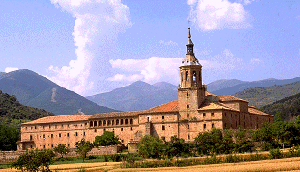 |
15 night Itinerary:
Day 1 - We meet in
the Spanish city of Bilbao. We don't stay there - it is just a
pick-up point so if you want a chance
to see the famous Guggenheim Museum we suggest you arrive a day
early and spend the night in Bilbao. The Guggenheim is devoted to 20th-century American
and European art and itself is a spectacular masterpiece of
architecture
Our meeting place
is the Barcelo Nervion Hotel in Bilbao at 2.30 pm. From here we
transfer by private coach to our first hotel in Roncesvalles
(about 2 hours).
Roncesvalles is a quiet hamlet located in a stunning mountain setting near the
French border at the end of the pass through the Pyrenees.
It is steeped in history. It was here that medieval
pilgrims arrived into Spain en route to Santiago from France
which is why this Camino route across Spain is often called the
"French Route". At Roncesvalles, pilgrims took refuge in the "Collegiata", a beautiful old
monastery that is now a museum. Our hotel is a lovely mountain
“pousada” surrounded by peaceful forest. Dinner
included
Day 2
-
ST JEAN TO RONCESVALLES This morning we travel a short distance by
private bus
across the border to the lively French village of St
Jean-Pied-de-Port. After a chance to sip a cafe-au-lait or
perhaps buy a souvenir walking stick, we are
taken by mini-bus up into the Pyrenees (weather permitting) and
from here we begin our walk following the high route through the
mountain pass. The walking is easy with only a
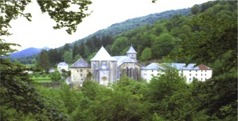 few
short ascents and after a few km the path gradually descends to
Roncesvalles. On a clear day the views are stunning with
snow-capped peaks in the distance and it is a spectacular start
to a Camino walk.
(If the weather
is inclement we walk the lower Val Carlos route from St Jean to
Roncesvalles). In medieval times the
high route was considered safer than the low road where ambushes
by robbers were frequent. We spend the night again at
Roncesvalles. You may wish to visit the Collegiata whose
construction is thought to have begun in the 900's. Its museum
contains artifacts and paintings associated with many legends
including the tomb of the legendary King Sancho El Fuerte (Sancho
the Strong) whose broken chains are part of the today’s symbol
of the region of Navarre.
Distance
12 km Dinner included
few
short ascents and after a few km the path gradually descends to
Roncesvalles. On a clear day the views are stunning with
snow-capped peaks in the distance and it is a spectacular start
to a Camino walk.
(If the weather
is inclement we walk the lower Val Carlos route from St Jean to
Roncesvalles). In medieval times the
high route was considered safer than the low road where ambushes
by robbers were frequent. We spend the night again at
Roncesvalles. You may wish to visit the Collegiata whose
construction is thought to have begun in the 900's. Its museum
contains artifacts and paintings associated with many legends
including the tomb of the legendary King Sancho El Fuerte (Sancho
the Strong) whose broken chains are part of the today’s symbol
of the region of Navarre.
Distance
12 km Dinner included
Day 3
-
PAMPLONA TO PUENTE LA REINA
Today we continue walking towards Pamplona through rolling
countryside. From Pamplona we are taken to the village of Puente
la Reina where we stay in a small inn located on a narrow,
cobble-stoned street which is still part of the pilgrim's path
that has scarcely changed for the past thousand years. At the end of the street is
the Puente La Reina (Queen's Bridge) built in the 1100’s and
still used today. In medieval times this was a strategic bridge
with a toll so whether the queen built the bridge to aid
pilgrims or to collect revenue is unknown. Legend says that an image of the Virgin Mary
that adorned the bridge was cared for by a small bird (txori)
and year after year when the bird washed the statue the
villagers deemed it a miracle and celebrated by ringing church
bells. As you cross the bridge (there is no toll charge) think
about the many notables
in whose foot-steps you are following including St Francis of Assisi, Lorenzo de Medici, Pope John
Paul II as they made
their way on foot across this bridge en route to Santiago.
Distance 20 km or
12 km (you
choose)
Dinner included
Day
4
- PUENTE LA REINA TO ESTELLA Our walk
continues through gentle countryside filled with vineyards and
tranquil villages of the La Rioja wine district. La Rioja wine
is the most famous in Spain but the region is also known for its
wonderful white asparagus and for a variety of fruit. Our walk
ends at the interesting town of Estella which sits astride a
craggy bend of a rushing river. There is time to explore and
perhaps indulge in an ice-cream cone before
we continue by bus to our accommodation, an amazing four-star
hotel inside a four-hundred year old monastery near Santo
Domingo. Distance
20 km or 12 km (you choose) Dinner
included
Day 5 - SANTO
DOMINGO TO BELORADO AND BURGOS Today’s
walk starts at Santo Domingo de la Calzada. Legend claims this
town was the setting for many miracles but the one where
chickens suddenly rose from the dead is the best known. Today,
the church at Santo Domingo houses live chickens said to be
descendants of those 12th century birds. From the old town we
walk towards Belorado. The route is in a wide valley surrounded
by high tablelands where caves once housed holy hermits. Later
we continue by bus into the fairy-tale city of Burgos where the
castle, palaces and monasteries reveal the city’s past grandeur.
In medieval times Burgos was the most significant stopping place
for pilgrims and today it contains a staggering wealth of art. Burgos
was the birth place of Spain’s legendary hero El Cid who, in
1094, fought with Christian forces against the Moors. His
body lies in the magnificent cathedral (the second largest in
Spain). We spend the night in an atmospheric hotel which faces
onto the cathedral plaza in the historic quarter of the city.
Distance 18 km or 9
km (you choose)
Day 6 -
BURGOS TO
CARRION DE LOS CONDES Our bus takes us
to today’s starting point on the Camino outside Burgos. From
here we walk through the “meseta”. the flat countryside of
Castile with its great plains and vistas. Later in the
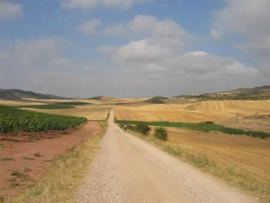 day
we reach Carrion de Los Condes, a town which, in the 11th
century, was the site of a magnificent monastery that gave refuge to
pilgrims. Today the historic San Zoilo monastery
has been converted to a comfortable hotel but still retains the creaky floors and atmosphere of medieval times with
its cavernous stone halls. Be sure to explore the beautiful old
cloisters before heading for the bar where the tinkle of glasses
blends with soft Gregorian chants
Distance 20 km or 12 km (you choose)
Dinner included
day
we reach Carrion de Los Condes, a town which, in the 11th
century, was the site of a magnificent monastery that gave refuge to
pilgrims. Today the historic San Zoilo monastery
has been converted to a comfortable hotel but still retains the creaky floors and atmosphere of medieval times with
its cavernous stone halls. Be sure to explore the beautiful old
cloisters before heading for the bar where the tinkle of glasses
blends with soft Gregorian chants
Distance 20 km or 12 km (you choose)
Dinner included
Day 7
- CARRION DE LOS CONDES TO
VILLACAZAR TO LEON
Today our walk continues through more of Castile’s
golden meseta that is easy walking.
On a clear day mountains are
visible in the distance but this part of the Camino follows an
ancient Roman road that is mostly flat. The breeze ripples
fields of grain as we walk alongside a small river. We stop at
the town of Villacazar which, in the 1200's, belonged to the
Knights Templar who defended holy places and patrolled the
Camino protecting pilgrims from bandits. There is a fascinating
Templar church called the "Church of the White Virgin" which is
associated with many legends and miracles. King Alfonso X
insisted the White Virgin cured pilgrim ailments although
perhaps he didn’t give enough credit to the hospitals in the
town. From here, late in the day, we continue by bus into Leon,
a remarkable city of soaring stone.
Our hotel in Leon is a lovely restored Posada in the heart of
the historic quarter.
Distance 15 km or
10 km (you choose) Dinner included
Day 8 - LEON Morning walking tour in Leon to explore the old quarter including the magnificent cathedral with stained glass windows preserved from the 13th century, the Basilica de San Isidoro with its Pantheon of Kings filled with golden treasures, the Hostal de San Marcos, the 16th century Palace of Los Guzmanes and the Casa de Botines, a 19th century building by the famous architect Antoni Gaudi. In the afternoon you may want to shop and to sample Leon’s many restaurants.
Day 9 -
ORBIGO TO
ASTORGA This morning we
drive from Leon to start our walk at Orbigo. It was here, on the
bridge at Orbigo, in 1434, that a knight, Suero, held what may
have been the last great medieval tournament. Having been
scorned by his lady love, Suero challenged other knights to a
joust. Today, if you stand on the bridge and use a little
imagination, you can almost hear the horses whinny and the clash
of steel. The tournament is still re-enacted each year by the
people of Orbigo. As we start to walk, the terrain changes from
flat plains to low foothills. The clouds ahead soon reveal
themselves to be chains of mountains in the distance but the
walking is still quite easy. In the afternoon we reach Astorga
with its Cathedral built in 1471 and a fairytale Bishop's Palace
designed by the eccentric architect Antoni Gaudi which now holds
an interesting "Museum of the Camino". The Museum of Chocolate tells the tale of the
local chocolate industry which flourished when cocoa was first
brought to Spain from the New World. The town still prides
itself in its great chocolate and there are many mouth-watering
window displays in the shops.
Distance 20 km or 12 km (you choose) Dinner included
Day 10 -
ASTORGA TO VILLAFRANCA Beyond Astorga we begin one of the most
historically important parts of the Camino over Mount Irago. Our
bus takes us up as far as Foncebadon and from here we ascend to
the Cruz de Ferro (iron cross) under which pilgrims
traditionally placed a
stone which they had carried from home as symbolic penance. It is
uphill but those who want to avoid the ascent can take the bus
to near the top. The surrounding terrain is rugged but with
lovely views and in spring the wildflowers are gorgeous. From
the top we descend gradually into the lush Bierzo valley and
along the way pass through the village of El Aciebo which
appears to be lost in a time-warp from the Middle Ages. We
continue down to the beautifully restored old town of
Molinaseca with its Roman bridge. Our reward at the end of the
day is staying at the lovely Parador at Villafranca with its
heated pool and spa. Villafranca is one of the most atmospheric
towns on the Camino and retains much of its medieval and
Renaissance atmosphere. In medieval times if a pilgrim was too
frail to continue his journey and stopped at Villafranca he was
granted the same papal indulgences as if he had reached Santiago. (of course he still
had to turn around and walk home) Distance
20 km or 12 km (you choose) Dinner included
Day 11 -
SARRIA TO PORTOMARIN
From Villafranca
we have a short bus ride up the Cebreiro pass and stop to visit
the hamlet of OCebreiro. Legend says that the Holy Grail (the
cup from which Christ drank at the Last Supper) is hidden at
OCebreiro (although many other places in the world make the same
claim). This is one of the most scenic stretches of the Camino.
The terrain is wild and rugged but then we descend into the
beautiful region of Galicia. Gray and green tones predominate
and one hears the "Gallego" language (local dialect). Villages
are strung along this part of the Camino - sometimes just a few
houses surrounding a stone church. Fields are fenced with stone
and brambles and one sees the ruins of castles that once
protected pilgrims. We begin today’s walk
at
the official 100 km mark near Sarria
and from here we walk to the village of Portomarin. In 1963,
during the dictator Franco’s era, the old town of Portomarin was
moved stone by stone from the valley to a hill to make way for a
reservoir. This was one of many of Franco's
improvement schemes (he was from Galicia) but nothing really succeeded until the revival
of the Camino. We stay at the Pousada de Portomarin overlooking
the lake and after dinner we sample. a "queimada" (a
flaming liqueur with sugar, lemon and coffee beans) and hear the
local ghost legend associated with the drink. Don't worry about
ghosts keeping you awake - if you sample a gueimada
you are guaranteed to sleep well.
Distance 19 km or 12 km (you choose) Dinner included
Day 12
-
PORTOMARIN TO PALAS DE REI
We follow a tranquil, hamlet-laden
trail through gently rolling countryside to Palas de Rei. The trail
winds alongside jewel-like green fields and between stone fences covered
with blackberries and wild-flowers. In
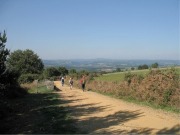 spring
the gorse is brilliant yellow and beautifully scented. In the
surrounding fields one sees "horreos" (granaries) and farmers using
agricultural methods that have changed little for centuries. On reaching Palas de Rei our bus takes us on a
short side-trip to the interesting town of
Lugo where we stay. Lugo is a UNESCO World Heritage Site with Roman
walls surrounding the town.
23 km or 12 km (you choose)
Dinner included
spring
the gorse is brilliant yellow and beautifully scented. In the
surrounding fields one sees "horreos" (granaries) and farmers using
agricultural methods that have changed little for centuries. On reaching Palas de Rei our bus takes us on a
short side-trip to the interesting town of
Lugo where we stay. Lugo is a UNESCO World Heritage Site with Roman
walls surrounding the town.
23 km or 12 km (you choose)
Dinner included
Day 13
- PALAS DE REI TO ARZUA In
the morning we return to
Palas de Rei to continue walking. The trail is easy with no long ascents
or descents. Those interested in local legends learn that this stage is
dominated by St Julian. Legend says that Julian was tricked by the devil
into killing his parents. To atone for his sin he ran a pilgrim hospital
and the church of San Julian do Camino illustrates the story. But the
Camino need not be just about saints or history. The next town of Melide has
shops, bars and restaurants scattered along the narrow streets. Melide
is famous for its "pulpo" (octopus cooked in it’s own juice in large
copper pots and sprinkled with paprika). If octopus for lunch doesn't
appeal, this region is also known for its wonderful cheeses made from
the milk of Galician cows that graze on the lush grass.
From Melide to Arzua
sections of the Camino are
on
farm tracks and occasionally
we may have to wait while a farmer
herds his cattle across the path. The local people welcome walkers.
Enterprising farm wives often sell fresh-picked fruit and home-made
sugar-coated pancakes to passers-by. Locals smile, wave and wish
walkers a "Buon Camino!". The trail passes through oak and eucalyptus forests that
offer both shade and a lovely fragrance. When we reach Arzua our bus
awaits and we return for the night to our hotel at Lugo. If there is
time you may want to try a dip in Lugo’s natural hot spring pools or try
walking atop the old Roman wall..
Distance 29 km or
less for those who are not trying for the Compostela certificate
Day 14 -
ARZUA TO RUA On the trail from Arzua to Rua we pass fields, oak groves
and small hamlets with bars catering to walkers. One enterprising local
brewer has even labelled his beer “Pilgrim Beer” in several languages.
The trail is undulating so there are some low hills but nothing steep or
difficult. Tonight we stay at a small boutique hotel and have an early start the
next morning.
Distance
19 km or less for those who are not trying for the Compostela
certificate
Dinner included
Day 15 -
RUA TO SANTIAGO Almost there! We are now on the
last stage of the Camino from Rua to Santiago. The Galician
countryside is fragrant with forests of eucalyptus and pine. By
mid-afternoon we approach Santiago and the Camino leads us to
the "Mount of Joy" where pilgrims first caught a glimpse of
Santiago Cathedral’s bell towers.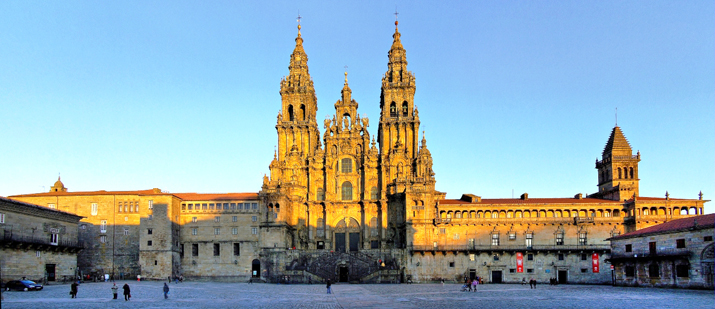
Tradition says that the first one of a group to arrive at the
top of Mount Joy was nicknamed Leroy (The King). Pilgrims also
stopped to wash at Lavacolla (probably the first time in months
since in the 1100's the use of soap and water was considered unhealthy).
We head for Santiago’s main square and the Cathedral, collect
our certificates, have a quick tour of the historic Cathedral
then check into our lovely hotel in the old quarter
Dinner included
Distance 19 km or
less for those who are not trying for the Compostela certificate
Day 16 - Our Camino experience ends after breakfast. Optional extra nights in Santiago can be booked so you can explore the city’s narrow medieval streets as well as its shops and cafes. Galician cuisine is known for its wonderful sea-food and its many varieties of local cheeses. You might want to take a local bus or a day tour to Finisterre (end of the earth) which was the traditional sea-side end to the Camino in the days when nobody knew that the world was round or what lay beyond that ocean. Here, pilgrims of old picked up a shell as a souvenir before they began the long walk home. Fortunately in the 21st century you don't need to walk home - there are planes or trains from Santiago to Madrid or buses to Porto. .
| Itinerary 15 nights | Itinerary 9 nights |
| Where we Stay | Frequently Asked Questions |
| Cost and Dates | Contact Us and Booking Information |
| Camino Home Page | Back to Walkers World Home Page |